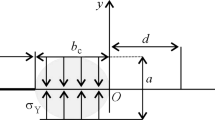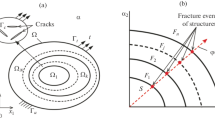Abstract
A number of studies devoted to the description of the entry of a celestial body into a planetary atmosphere are analyzed. It is shown that one can obtain an adequate qualitative pattern of the phenomenon with the use of an integral fracture criterion if the necessary energy condition of fracture is satisfied. The use of the traditional fracture criteria for materials does not give a correct description of the process considered.
Similar content being viewed by others
References
A. A. Griffith, “The phenomenon of rupture and flow in Solids,”Philos. Trans. Roy. Soc., London,A221, 163–198 (1920).
E. Wessel, W. Clark, and W. Pryile, Calculations of steel structures with large cuts by the methods of fracture mechanics,” in:New Methods of Estimating the Resistance of Metals to Brittle Fracture [Russian translation], Mir, Moscow (1972).
G. P. Cherepanov,Mechanics of Brittle Fracture [in Russian], Nauka, Moscow (1974).
V. Z. Parton,Fracture Mechanics: from Theory to Practice [in Russian], Nauka, Moscow (1990).
A. G. Ivanov, Dynamic fracture and scaling effects,”Prikl Mekh. Tekh. Fiz.,35, No. 3, 116–131 (1994).
Yu. I. Fadeenko, “Fracture of meteoric bodies in the atmosphere,”Fiz. Goreniya Vzryva,3, No. 2, 276–280 (1967).
S. S. Grigoryan, “The nature of the Tunguska meteorite”Dokl. Akad. Nauk SSSR,231, No. 1, 57–60 (1976).
S. S. Grigoryan, “Motion and fracture of meteorites in planetary atmospheres,”Kosm. Issled.,17, No. 6, 875–893 (1979).
S. S. Grigoryan, “Collision of the Schoemaker-Levy-9 comet with Jupiter in July of 1994,”Dokl. Akad. Nauk SSSR,338, No. 6, 752–754 (1994).
V. P. Korobeinikov, V. I. Vlasov, and D. B. Volkov, “Modeling of fracture of space bodies during motion in planetary atmospheres,”Mat. Model.,6, No. 8, 61–75 (1994).
V. I. Kondaurov, I. N. Lomov, and V. E. Fortov, “Deformation, fracture, and evaporation of the substance of a fragment of the Schoemaker-Levy-9 comet during motion in Jupiter’s atmosphere,”Dokl. Akad. Nauk SSSR,344, No. 2, 184–188 (1995).
A. G. Ivanov, “The nature of catastrophic fractures of pipelines,”Dokl. Akad. Nauk SSSR,285, No. 2, 357–360 (1985).
M. A. Makhutov, S. V. Serikov, and A. G. Kotousov, “Escalating fracture of pipelines,”Probl. Prochn., No. 12, 10–15 (1992).
A. G. Ivanov, “Spalling in a quasiacoustic approximation,”Fiz. Goreniya Vzryva,11, No. 3, 475–480 (1975).
A. G. Ivanov and V. A. Ryzhanskii, “Possible nature of the explosion of the Tunguska meteorite and the breakup of the Schoemaker-Levy comet,”Fiz. Goreniya Vzryva,31, No. 6, 117–124 (1995). [The correction inFiz. Goreniya Vzryva,32, No. 3 (1996).]
A. G. Ivanov and V. A. Ryzhanskii, “Fragmentation of a small celestial body during its interaction with a planetary atmosphere,”Dokl. Akad. Nauk SSSR,353, No. 3, 334–337 (1997).
Additional information
Institute of Experimental Physics, Sarov 607190. Translated from Prikladnaya Mekhanika i Tekhnicheskaya Fizika, Vol. 40, No. 3, pp. 191–195, May–June, 1999.
Rights and permissions
About this article
Cite this article
Ivanov, A.G. Adequacy of the description of the process of fracture in computer simulations. J Appl Mech Tech Phys 40, 527–530 (1999). https://doi.org/10.1007/BF02468412
Received:
Revised:
Issue Date:
DOI: https://doi.org/10.1007/BF02468412




